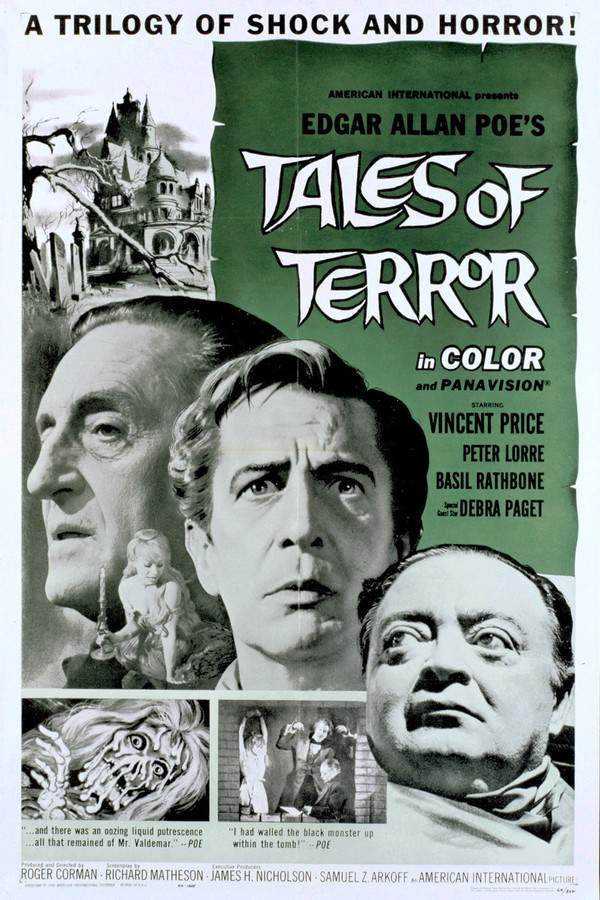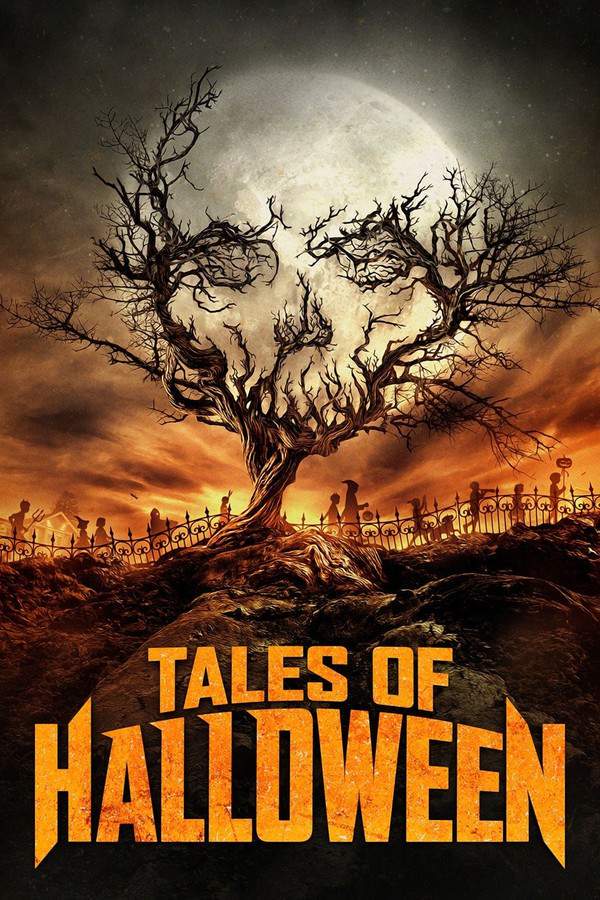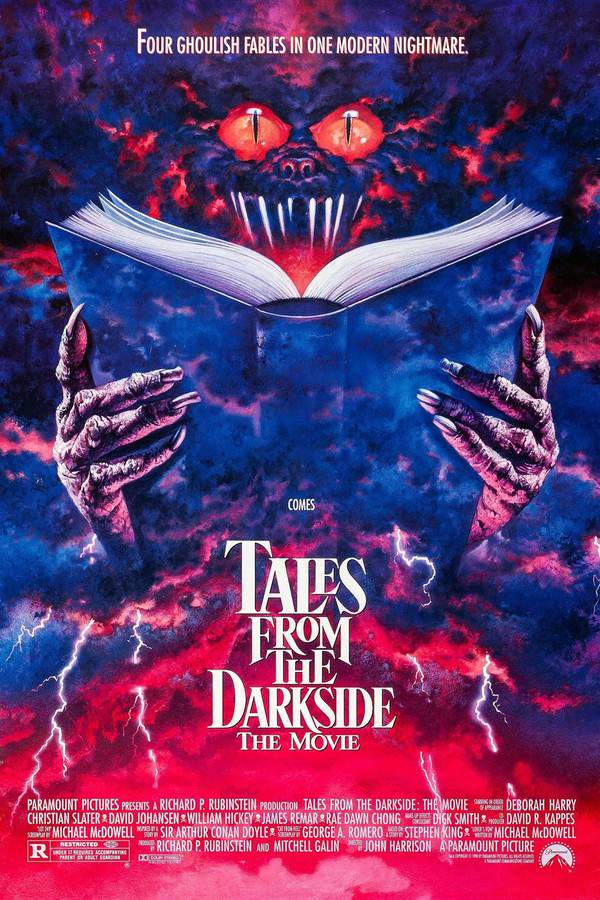
Tales of Terror 1962
Test your knowledge of Tales of Terror with our quiz!
Tales of Terror Plot Summary
Read the complete plot summary and ending explained for Tales of Terror (1962). From turning points to emotional moments, uncover what really happened and why it matters.
In this unnerving adaptation of Edgar Allan Poe’s classic stories, Vincent Price guides us through three chilling segments that delve into the darker corners of the human psyche. The initial tale centers around Lenora Locke, who makes a harrowing return to her father’s dilapidated mansion, only to find him engulfed in sorrow and loss. His silence speaks volumes, hinting at a profound guilt he harbors, believing that Lenora is to blame for her mother’s tragic demise, Morella.
As Lenora embarks on an unsettling journey to uncover the painful mysteries of her family’s past, she is confronted by the horrifying sight of her mother’s decaying body, forever arrested in a grotesque tableau. This revelation triggers a series of dreadful events that culminate in a spine-chilling encounter with the vengeful spirit of Morella. In a fantastical twist, Lenora’s existence is extinguished while Morella’s corpse is resurrected, reclaiming its former beauty. The horrific exchange of their bodies leaves Lenora’s father to confront his nightmarish fate amidst a consuming blaze.
The second tale spins around Montresor Herringbone, who is consumed by a profound loathing for his wife, Annabelle, and her mysterious black cat. His resentment grows fitfully as he grapples with his own feelings of inadequacy, turning increasingly to wine to dull the misery of his life. The arrival of Fortunato Luchresi serves as the catalyst for his downfall, leading Herringbone to entomb both his wife and her feline in an act of brutal desperation.
Within this self-imposed prison, Herringbone faces relentless torment from the apparition of the black cat alongside the shadow of his own guilt. As this segment concludes, the chilling sentiment from Poe resonates through the air: >“I had walled the black monster up within the tomb!” evoking a sense of suffocating dread that envelops the viewer.
In the final narrative, M. Ernest Valdemar battles against a debilitating illness, seeking the eccentric help of Mr. Carmichael, a hypnotist known for his mental manipulations. As Valdemar succumbs to a series of trance states, he becomes ensnared in a perilous limbo between life and death, his cries for release falling on deaf ears as Carmichael callously withholds the relief he yearns for.
As weeks of torment drag on, Valdemar’s body begins to decay, yet Carmichael remains firmly in command, eagerly pursuing the affections of Valdemar’s devoted wife, Helene. Despite his malevolent strategies, Helene fiercely resists Carmichael’s lewd advances. The tension escalates into brutal violence when Carmichael launches a savage attack on her. In a shocking twist, the decaying form of Valdemar rises from its grave, fueled by a furious vengeance directed at the tormentor who prolonged his anguish. As the physician, Dr. Elliot James, rushes to the chaos, he finds Helene narrowly escaping the terrifying horror that has been unleashed from the depths of death.
Tales of Terror Timeline
Follow the complete movie timeline of Tales of Terror (1962) with every major event in chronological order. Great for understanding complex plots and story progression.
Lenora Returns Home
Lenora Locke arrives at her father's crumbling mansion, confronting the exposed emotional scars that linger there. The eerie atmosphere is amplified by her father's profound silence, which seems to communicate the heavy guilt he bears for her mother's death.
Confrontation with Guilt
As Lenora navigates the shadowy halls of the mansion, she senses the weight of her father's unspoken blame for her mother's tragic demise. The air is thick with sorrow and regret as she begins to unravel the secrets that bind her family's past.
Discovery of Morella's Body
Lenora stumbles upon the morbid sight of her mother's decaying corpse, which has been grotesquely positioned as if frozen in time. This horrifying revelation marks the beginning of Lenora's descent into a nightmarish truth about her family.
The Spirit's Revenge
Haunted by the specter of her mother, Morella, Lenora's existence takes a dark turn as the vengeful spirit seeks retribution. The clash between the living and the dead culminates in a terrifying exchange that alters their fates irreversibly.
Body Swap
In a grotesque twist of fate, Lenora becomes extinguished as Morella's body is resurrected, returning to its former beauty. This shocking transformation leaves Lenora's father grappling with the haunting aftermath of his daughter's fate.
Montresor's Growing Hatred
The focus shifts to Montresor Herringbone, who is consumed by a deep-seated loathing for his wife, Annabelle, and her uncanny black cat. His resentments fuel his growing misery, and he increasingly resorts to alcohol to numb his despair.
The Catalyst Appears
Montresor’s life takes a sinister turn with the arrival of Fortunato Luchresi, a man whose presence intensifies Montresor's feelings of inadequacy. This jealousy reaches a boiling point, spurring him into a violent and desperate act.
Brutal Crime
In a moment of reckless despair, Montresor entombs both Annabelle and her black cat within the walls of his home. This tragic act seals both their fates and plunges Montresor deeper into his self-made torment.
Tormenting Apparition
Within the confines of his own creation, Montresor is haunted by the ghostly presence of the black cat. His guilt manifests into relentless torment, echoing the darkness of his actions, leaving him suffocated by his own misdeeds.
Valdemar's Illness
The final tale introduces M. Ernest Valdemar, who is plagued by a debilitating illness and seeks the dubious help of Mr. Carmichael, a hypnotist. As he succumbs to Carmichael's control, Valdemar finds himself teetering on the edge of existence.
Descent into Limbo
Caught in a series of trance-like states, Valdemar becomes entrapped in a perilous limbo between life and death. His desperate pleas for freedom go unheard as Carmichael revels in the power he wields over the dying man.
Carmichael's Malice
As the weeks of torment pass, Valdemar's physical state deteriorates while Carmichael grows increasingly bold, attempting to seduce Valdemar's devoted wife, Helene. The tension escalates, revealing the depths of Carmichael's depravity.
Helene Resists
Facing the advances of Carmichael, Helene fiercely defends her loyalty to Valdemar, despite the mounting threat. Her resistance sparks a violent confrontation, heightening the stakes of the chilling narrative.
Revenge from Beyond
In an astonishing climax, the decaying form of Valdemar rises from the grave, driven by a furious need for vengeance against Carmichael. This shocking resurrection unleashes chaos and horror as the past collides with the present.
The Final Escape
As Dr. Elliot James rushes to the scene, he finds Helene barely escaping the chaos unleashed by Valdemar's return. The horrors of the night culminate in a thrilling yet terrifying conclusion, leaving a lasting impression of dread.
Tales of Terror Characters
Explore all characters from Tales of Terror (1962). Get detailed profiles with their roles, arcs, and key relationships explained.
Lenora Locke
Lenora is a complex character haunted by her family's tragic history. Her journey back to her father's mansion forces her to confront her past and the guilt that surrounds it. As she uncovers the dark truths of her family, Lenora's innocence is shattered, leading to a horrifying transformation.
Montresor Herringbone
Montresor is consumed by loathing and jealousy, particularly towards his wife and her connection to a black cat. His character portrays the destructive nature of resentment, showcasing how it can lead to moral decay and tragic decisions. His eventual descent into insanity illustrates the tragic consequences of unbridled emotion.
M. Ernest Valdemar
Valdemar is a tragic figure caught between life and death, enduring torment as he grapples with illness. His character explores themes of helplessness and manipulation as he finds himself at the mercy of a callous hypnotist. The climax of his story reveals the terrifying consequences of enduring prolonged suffering.
Mr. Carmichael
Carmichael serves as the antagonist in Valdemar's story, a sinister hypnotist exploiting others for his gain. His malevolence contributes to the atmosphere of dread, as he embodies the fear of losing control over one's own fate. His aggressive pursuits and manipulative tactics escalate the tension in the narrative.
Helene
Helene is Valdemar's devoted wife, showcasing strength and resilience in the face of Carmichael's advances. Her character represents loyalty and the fight against oppression, determined to protect her husband despite the danger. Helene's struggle amplifies the emotional stakes of the final act.
Tales of Terror Settings
Learn where and when Tales of Terror (1962) takes place. Explore the film’s settings, era, and how they shape the narrative.
Time period
The film evokes a timeless atmosphere, blending elements of the 19th-century Gothic tradition with a modern sensibility. Its setting allows for a focus on psychological horror, transcending specific historical context to explore universal themes of grief and guilt. This creates a haunting resonance that binds the narratives together.
Location
dilapidated mansion
The story takes place primarily in a decaying mansion, a symbol of unresolved grief and loss. It is foreboding and filled with dark secrets, representing the haunted history of Lenora Locke's family. The mansion serves as both a physical and emotional landscape, where memories of tragedy and sorrow permeate every corner.
Tales of Terror Themes
Discover the main themes in Tales of Terror (1962). Analyze the deeper meanings, emotional layers, and social commentary behind the film.
🕯️
Guilt
Guilt acts as a pervasive theme throughout the film, manifesting in the characters' actions and decisions. Lenora's father grapples with guilt over her mother's death, while Montresor's hatred for his wife leads him to a dark place of desperation. This emotional burden ultimately drives them to tragic fates, underscoring the psychological effects of unresolved guilt.
👻
Supernatural
The supernatural elements in the film highlight the intersection between life and death, particularly through the vengeful spirit of Morella and Valdemar’s resurrection. These ghostly figures serve as manifestations of the characters' inner turmoil, illustrating how past traumas haunt the living, blurring the lines between reality and the spectral.
🍷
Despair
Despair permeates the narratives, from Lenora’s fear and loneliness to Montresor's self-destructive behavior fueled by his inadequacies. Each character's journey reflects a struggle against their inner demons, which ultimately leads to tragic consequences. This sense of hopelessness is palpable, depicting the characters' descent into madness.

Coming soon on iOS and Android
The Plot Explained Mobile App
From blockbusters to hidden gems — dive into movie stories anytime, anywhere. Save your favorites, discover plots faster, and never miss a twist again.
Sign up to be the first to know when we launch. Your email stays private — always.
Tales of Terror Spoiler-Free Summary
Discover the spoiler-free summary of Tales of Terror (1962). Get a concise overview without any spoilers.
In the shadow‑laden world of Tales of Terror, the legendary voice of Vincent Price drifts through three self‑contained stories, each a study in dread and fascination. The anthology’s tone is unmistakably gothic: candle‑lit corridors, crumbling estates, and an oppressive atmosphere where every whispered breath feels like a promise of something unseen. Themes of revenge, obsession, and mortality thread through each vignette, inviting the audience to linger in the uneasy spaces between what is spoken and what lurks just beyond sight.
The first segment follows Lenora as she returns to her family’s dilapidated mansion, a place heavy with grief and lingering sorrow. There she finds a father haunted by loss, his silence echoing the weight of a past that refuses to stay buried. Their fragile bond and the house’s decaying grandeur create a palpable tension, hinting at secrets that may finally surface under the strain of lingering regrets.
In the second story, Montresor grapples with an all‑consuming fixation that saps his sanity, while the presence of a rival sharpens the edges of his disquiet. Set against a backdrop of domestic unease, his relationship with those closest to him becomes increasingly strained, suggesting that the true horror may arise from the mind’s own compulsions as much as any external menace.
The final tale introduces Ernest—a man whose life is ebbing away—and the enigmatic hypnotist Carmichael who offers a controversial escape from mortality. As Ernest’s fragile health wanes, his devoted wife Helene navigates a fraught alliance, caught between hope and desperation. The interplay of fragile human will, looming death, and unsettling manipulation casts a lingering chill, promising a conclusion as inevitable as it is unsettling.
Can’t find your movie? Request a summary here.
Movies with Similar Twists and Themes
Uncover films that echo the narrative beats, emotional arcs, or dramatic twists of the one you're exploring. These recommendations are handpicked based on story depth, thematic resonance, and spoiler-worthy moments — perfect for fans who crave more of the same intrigue.
Featured on this page

What's After the Movie?
Not sure whether to stay after the credits? Find out!
Explore Our Movie Platform
New Movie Releases (2026)
Famous Movie Actors
Top Film Production Studios
Movie Plot Summaries & Endings
Major Movie Awards & Winners
Best Concert Films & Music Documentaries
Movie Collections and Curated Lists
© 2026 What's After the Movie. All rights reserved.











